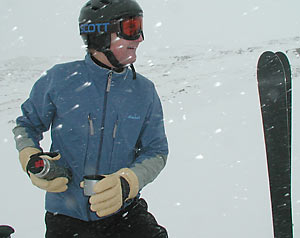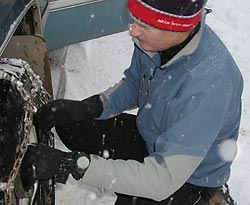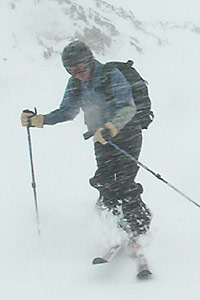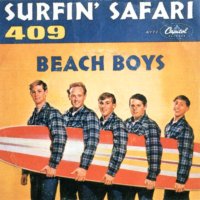
Canadian mountain pioneer A. A. McCoubrey in his soft shell, circa 1910. (photo courtesy of Whyte Museum)
What do surf music and soft shell jackets have in common? I’ll get to that in a few paragraphs. For now, suffice it to say that soft shell jackets have been around for a while. Mountaineers of the 1800s pressed their woolen jackets into service as soft shells, replete with lapels and what must have been a breezy opening at the neck. When I taught at the National Outdoor Leadership School in the 1970s, we’d walk for days through drizzle and fog with nothing more than a wool shirt as our shell. We remained comfortable and dry, only breaking out our non-breathable ponchos or cagouls when the rain came in torrents.
Note: In the vernacular of technical clothing “soft shell” means a garment worn as an outer layer to protect against precipitation and wind. “Soft” means that instead of using slick nylon fabric, the soft shell is built with tightly woven, softer fabric similar to that of stretch ski pants.
The advent of waterproof-breathable caused many of us woolly guys to dress differently. We optimistically believed the hype, and spent the next several decades in jackets that worked well when new, in low humidity, when you weren’t working too hard — but bore an uncomfortable similarity to wearing a trash bag as soon as copious moisture entered the picture, be it from sky or skin.

Lou testing the Serendipity in a harsh timberline blizzard.
For me, the worst scenario was a light misting drizzle or light snowfall, combined with a hard uphill push. In a synthetic open weave top (generically known as “polypro”), I’d be wet to the skin in moments, and chill to the bone as soon as I stopped moving. If I donned my waterproof-breathable shell, I’d overheat and drip with sweat, and still freeze when my body heat output slowed down. Ditto for fleece. Not going back to the NOLS method demonstrates a certain amount of stupidity on my part, but then, I’m as much a serial fashion victim as the next person.
Thus, when the concept of “soft shell” hit the outdoor apparel market a while back, I laughed a cynical laugh, said something about “the more things change…,” then immediately craved one of my own. Experience had shown me the concept works — I was eager to see how modern fabrics would spin an old standard.
Recently, Cloudveil graciously provided me with their Serendipity soft shell jacket, and I put it through an excellent series of tests. I wanted to see if this high tech version of my NOLS wool really was an improvement. And, even if it worked just as well, it would still be an excellent garment for most of my climbing and ski mountaineering.
The Serendipity, as well as other Cloudveil clothing, is made with Schoeller Dryskin (a high-tech blend of nylon, Cordura, Lycra and Coolmax fabrics treated with a water repellent chemical that’s said to improve wicking as well as water resistance) My jacket, in size medium, has a flattering and trim fit — it’s obviously made for an athletic build (though it did do a good job of hiding my waistline accessories).
Considering its buff heritage (Teton hard folks), I was surprised at how tight the sleeves are. This causes a bit of binding when I layer heavy under the shell, but is perhaps a necessary tradeoff, as trim-fitting soft shells are more appealing, weigh less, and pack better than baggy versions. As for details, I like the two huge “Napoleon” pockets with openings located above my pack waistbelt (I can actually use them), the collar is perfect, and the wrist closures are simple and easy to operate. If I had any quibbles with the other details I’d share them, but I truly do not.

Another test, chain up in a snowstorm.
Okay, on to the real world. For my first test, I wore the Serendipity during a lengthy valley slog in pursuit of late October snow. With the sun low in the sky and a cold breeze in my face, I acted on faith and started out with nothing more than a thin acrylic top under the Serendipity. A light snow fell for most of the trip, and once we broke timberline a howling wind ripped a ground blizzard over our shoulders. The jacket was beautiful. I was incredibly comfortable during the slog, when before I’d have been playing with wearing my unzipped waterproof breathable, or suffering under a chilly micro layer that felt like skiing shirtless. Up in the windy heights, I could feel that the Schoeller fabric didn’t block air quite the way my Goretex did, but was nonetheless effective as a wind screen.
I love to take gear to its limits, and my next test did exactly that. Fresh powder waited in the mountains, freezing rain was falling in my yard at home. Donning my Serendipity, I started my morning chores. Trash out; still dry. Carry boot bag out to car; still dry. Get skis from garage and stand under water pouring from roof eve — finally, a bit of wet through the shoulders. Wow, it took a waterfall to get through the thing! Up in the mountains I skied for several hours in wet wind-driven sleet. While I didn’t stay bone dry, I can honestly say I ended up dryer than I would have if I’d sweated under my Gortex shell or tried to go it in my fleece.

Full conditions ski touring in a soft shell.
I took the Serendipity on several other extreme outings, and was constantly pleased and surprised by how well it worked. Before long it became an essential part of my alpine wardrobe, which introduced a problem: I don’t mind going without a waterproof breathable shell on short trips, or if I’m certain the weather will be terrific. But reality is that no soft shell as comfortable as the Serendipity will keep you dry in a torrential rain or hours of wet sleet. So for overnights or longer days in uncertain weather, I still need to carry a truly waterproof shell, thus ending up with more layers (and weight) than necessary. My solution is to carry a super-lightweight and simplistic waterproof breathable jacket, and to pack a bit thinner fleece since the Serendipity is also an insulating layer. With these adjustments my clothing system is now better than ever. Hail the modern soft shell!

The Beach Boys in their soft shells, headed for a chilly morning on the sand? Public relations image used to illustrate writing pertaining directly to subject per normal permissions for such.
What about surf music? While you know surf music is old stuff (too old?), you might think plaid wool shirts as soft shells have only been in style since some Portland grunge kid found one in a thrift shop in 1989. Nope.
Forty years ago, surf music pioneers The Beach Boys, then called the “The Pendletones,” made the Pendleton plaid wool shirt popular as a practical outdoor clothing piece as well as a style statement. Wearing the wool shirts as jackets over tee shirts and jeans became the band’s signature look and appeared on many album covers throughout the 1960’s, including their first album Surfin’ Safari, and their second, Surfer Girl.
WildSnow.com publisher emeritus and founder Lou (Louis Dawson) has a 50+ years career in climbing, backcountry skiing and ski mountaineering. He was the first person in history to ski down all 54 Colorado 14,000-foot peaks, has authored numerous books about about backcountry skiing, and has skied from the summit of Denali in Alaska, North America’s highest mountain.
